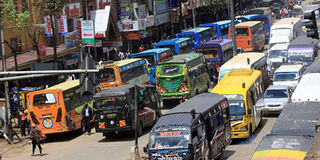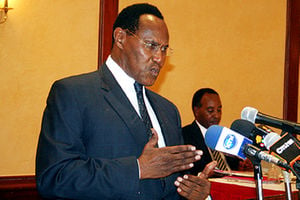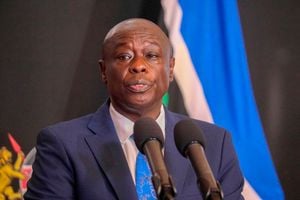Nairobi needs metro transport system

Matatus along Tom Mboya Street in Nairobi. Reorganising public service transport is inevitable. PHOTO | FILE | NATION MEDIA GROUP
What you need to know:
- The manner of introduction and enforcement aside, the situation in downtown Nairobi is untenable and must be addressed soon.
- The metropolitan-wide transport system that has the potential to revive the city county’s economy, create jobs and tackle runaway crime.
No doubt, development in downtown (meaning lower side of) Nairobi City has been vigorous in recent years.
Pre-independence buildings that were hardly two to three floors high have been brought down, paving the way for skyscrapers on the other side of Tom Mboya Street.
The hitherto dingy, smoky bars and butcheries that were once the sanctuary of traditional liquor dealers and their noisy customers are now modern classy lodges, hotels, restaurants and entertainment joints patronised by local and foreign clientele alike.
Put differently, this is no longer the crime-ridden burglar-infested den of yore. Even the big banks are part of the landmarks in this part of the capital city.
And if you still think that downtown Nairobi has been left behind in terms of service — and information-based economy — then visit such joints as Prearea Hotel on Duruma Road, Veecam Hotel at the junction of Cross Road and Accra Road or Beams Hotel, which was once Old Nyanza Club, on Mfang’ano Street, that christens itself as the ‘House of Rumba’.
TECHNOLOGY
You will be shocked at the level of round-the-clock Wi-Fi connectivity that drives emerging businesses there.
These, and many others, are now the attraction of a laptop computer-brandishing middle class from the sprawling estates east of the city centre, who once depended on cybercafes (which spread like bush fire as Nairobi embraced computer service- and information-based technology in the 1990s) to process their paper work.
Suffice it to say that the building boom in this part of Nairobi has not only produced new tax revenue streams for the city and the national government; it has also called for additional expenditures for the two levels of government.
These include supply of electricity, water, sanitation and public service transport.
TRANSPORT
The mounting traffic congestion in the streets such as Accra Road, Tom Mboya Street, Latema Road, River Road and Luthuli Avenue has, in recent years, has seen the most unlikely junctions turned into stages for picking up and dropping off passengers in the morning and evenings as winding queues take over pedestrian walkways and shop verandas.
That is not limited to the downtown district; similar snarl-ups are experienced on the highways, crossroads, bridges and tunnels along Thika Superhighway, Uhuru Highway, Chiromo Road and Waiyaki Way.
The situation calls for corresponding policy responses to prevent the current state of affairs from deteriorating.
Reorganising public service transport as Nairobi Governor Mike Sonko attempted to do late last year is inevitable.
Those travelling from central Kenya and getting in through Thika Superhighway were to be dropped off at Ngara terminus, those from Eastlands at Muthurwa Market and those entering from Uhuru Highway, at Land Mawe.
Only commuters entering the city through Haile Selassie Avenue would have been brought up to the railway station.
POLICY
Granted, Governor Sonko sought to enforce the measures in a rush. But the policy has been in place for a while.
One would have thought there would be some serious review before enforcement.
The manner of introduction and enforcement aside, the situation in downtown Nairobi is untenable and must be addressed soon.
The challenge for the ‘city fathers’ is to ensure that those who depend on public service vehicles and those who find it more convenient to use their cars can access the city in the least inconveniencing manner.
Downtown business districts of Nairobi such as ‘Commercial’ and the outlying suburbs like Ngara, Westlands, Muthurwa and the neighbouring Gikomba markets should be at the hub of a metropolitan-wide transportation system that city authorities have failed to move from its conceptual stage to a reality.
ECONOMY
Only such a system will assure efficient and convenient access to jobs for everyone — from top executives of blue chip companies to the clerical, administrative and custodial workers employed to service and protect these investments.
Luckily for Mr Sonko and his administration, among President Uhuru Kenyatta’s development targets are to boost manufacturing, provide affordable housing and universal health coverage and create jobs.
If at all Mr Sonko has any New Year resolutions for 2019, they must, of necessity, include one that will see his government implement, for once, the metropolitan-wide transport system that has the potential to revive the city county’s economy, create jobs and tackle runaway crime.
Mr Churchill is the presiding convener of the Civil Society Reference Group. [email protected]





